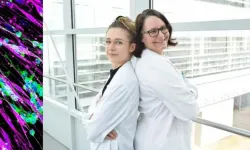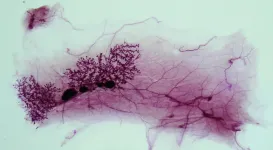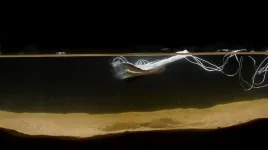What sounds contradictory at first glance, namely firing a tumor with a growth factor, makes sense in neuroblastoma. Neuroblastoma is a tumor of the peripheral nervous system and the most common solid cancer in early childhood. In contrast to malignant neuroblastomas, benign neuroblastomas contain, next to tumor cells, many "Schwann cells". These cells normally protect and repair nerve cells. The results of the now published study indicate that Schwann cells in neuroblastoma stimulate tumor cells to mature, thereby halting their unchecked growth.
A cell that stops tumor growth... To accomplish this, Schwann cells produce, among other factors, a signaling molecule called epidermal growth factor like 8 (EGFL8). The research team demonstrates that EGFL8 stimulates the differentiation, or maturation, of neuroblastoma cells. "Until recently, we only knew that this protein existed, but its function was not known. We now for the first time know where EGFL8 is produced and how it acts," explains study author Sabine Taschner-Mandl, PhD, head of the Tumor Biology Group at St. Anna Children's Cancer Research Institute. Furthermore, the study results show that high levels of EGFL8 was associated with better survival rates in neuroblastoma patients.
"In cell cultures, we have demonstrated that Schwann cells as well as their secreted signaling molecules exert anti-tumor effects, even in aggressive neuroblastoma cells. Thus, we are able to exploit a process that occurs naturally in benign neuroblastomas to stop the malignant ones," Sabine Taschner-Mandl and her colleague Tamara Weiss, PhD, from the Medical University of Vienna, explain. In addition to EGFL8, other, yet uncharacterized Schwann cell molecules could also provide targets for cancer therapies in the future. However, the effects of Schwann cells are presumably much more extensive: the research team is currently investigating how Schwann cells manipulate immune cells in their environment.
...and promotes the healing of injured nerve fibers The present study provides another significant finding: Schwann cells in benign neuroblastomas have a similar cellular status to those Schwann cells that support the healing of injured peripheral nerves. Direct comparison revealed that Schwann cells in the tumor express certain repair-associated genes and show specific repair functions. "It is amazing that we have discovered a signaling molecule that plays a role in both tumor development of benign neuroblastomas and regeneration of injured nerves. Since EGFL8 stimulates the formation of nerve cell extensions, it could be of great importance for the treatment of injured nerve fibers", says Tamara Weiss.
Prospective application in aggressive tumors It is conceivable that EGFL8 and other factors produced by Schwann cells could be applied in the treatment of nerve damage as well as aggressive neuroblastoma. "Using phosphoproteomics, we were able to decipher which signaling pathways are activated by EGFL8 in neuroblastoma cells. There are major differences compared to cells that have not been stimulated with EGFL8," Sabine Taschner-Mandl says. In addition to EGFL8, these downstream signaling pathways also represent potential targets for future treatments. "There is still a long way to go before these findings ultimately reach the patient. But we have now laid the foundation for taking the next steps."
INFORMATION:
Photo: Sabine Taschner-Mandl, PhD, and Tamara Weiss, PhD
Copyright: St. Anna Children's Cancer Research Institute
Image: Immunofluorescence image of Schwann cells (magenta) and neuroblastoma cells (green)
Copyright: Weiss T, Taschner-Mandl S et al., Nature Communications 2021
Publication
Schwann cell plasticity regulates neuroblastic tumor cell differentiation via epidermal growth factor like protein 8
Tamara Weiss#, Sabine Taschner-Mandl#,* , Lukas Janker, Andrea Bileck, Fikret Rifatbegovic, Florian Kromp, Helena Sorger, Maximilian O. Kauer, Christian Frech, Reinhard Windhager, Christopher Gerner, Peter F. Ambros, Inge M Ambros
#Contributed equally
*Corresponding author
Nature Communications, March 12, 2021
DOI: 10.1038/s41467-021-21859-0
https://doi.org/10.1038/s41467-021-21859-0
http://www.nature.com/ncomms
Funding
This study was supported by the Austrian Research Promotion Agency (FFG) grants (ID:844198, TisQuant, EraSME, to P.F. Ambros and VISIOMICS, Coin Networks, to S. Taschner-Mandl), the European Union's Seventh Framework Program (FP7/2007-2013) under the project ENCCA, grant agreement HEALTH- F2-2011-261474 and under the project Modicell (MC-IAPP Project 285875), the Herzfeldersche Familienstiftung and St. Anna Children's Cancer Research Institute
About Sabine Taschner-Mandl, PhD
Sabine Taschner-Mandl, PhD has been head of the Tumor Biology group at St. Anna Children's Cancer Research since 2018, where she has been working as a scientist since 2008. In addition, she is a lecturer at the Medical University of Vienna and Vienna University of Technology. Dr. Taschner-Mandl completed her studies of biology at the University of Vienna with a diploma thesis in vaccine development at Intercell. This was followed by a dissertation and a post-doctoral position at the Institute of Immunology at the Medical University of Vienna. Besides her research work at St. Anna Children's Cancer Research Institute, Dr. Taschner-Mandl was a visiting scientist at Significo and the University of Helsinki as part of the EC-FP7 Marie Curie Program.
For her research, Dr. Taschner-Mandl has received numerous grants, among others from the Austrian Research Promotion Agency, the Vienna Science, Research and Technology Fund, and the European Commission's ERA-NET initiative.
About Tamara Weiss, PhD
Tamara Weiss, PhD, is team leader of the Plastic and Reconstructive Surgery Research Laboratory at the Medical University of Vienna. There she teaches and continues her projects in close cooperation with different departments of the Medical University of Vienna, the University of Vienna and St. Anna Children's Cancer Research Institute.
Tamara Weiss studied Molecular Biology at the University of Vienna and performed research for her thesis as a visiting scientist in the Anne McLaren Laboratory for Regenerative Medicine at the MRC Cambridge Stem Cell Institute at the University of Cambridge. She dedicated her PhD project at St. Anna Children's Cancer Research Institute to the comprehensive characterization of human Schwann cells and has since specialized in studying the role of Schwann cells in regeneration and pathologies of peripheral nerves, as well as in different tumors.
About St. Anna Children's Cancer Research Institute, CCRI
St. Anna CCRI is an internationally renowned multidisciplinary research institution with the aim to develop and optimize diagnostic, prognostic, and therapeutic strategies for the treatment of children and adolescents with cancer. To achieve this goal, it combines basic research with translational and clinical research and focus on the specific characteristics of childhood tumor diseases in order to provide young patients with the best possible and most innovative therapies. Dedicated research groups in the fields of tumor genomics and epigenomics, immunology, molecular biology, cell biology, bioinformatics and clinical research are working together to harmonize scientific findings with the clinical needs of physicians to ultimately improve the wellbeing of our patients.
Learn more: http://www.kinderkrebsforschung.at
http://www.ccri.at
About Medical University of Vienna (MedUni Vienna)
MedUni Vienna is one of the most traditional medical education and research facilities in Europe. With almost 8,000 students, it is currently the largest medical training center in the German-speaking countries. With its 30 university hospitals and two clinical institutes, 12 medical theory centers and numerous highly specialized laboratories, it is also one of Europe's leading research establishments in the biomedical sector.
http://www.meduniwien.ac.at
About University of Vienna
The University of Vienna provides great and diverse impetus. In the field of research, it cooperates with industry, cultural institutions and society. Approximately 10,000 students graduate from the University of Vienna every year. The University prepares them for a professional career and encourages critical thinking and self-determined decision-making.
The University of Vienna is one of the oldest and largest universities in Europe: About 9,900 employees, 6,900 of whom are academic employees, work at 20 faculties and centers. This makes the University of Vienna Austria's largest research and education institution: About 89.000 national and international students are currently enrolled at the University of Vienna. With 178 degree programs, the University offers the most diverse range of studies in Austria. The University of Vienna is also a major provider of continuing education and training in Austria.
http://www.univie.ac.at






